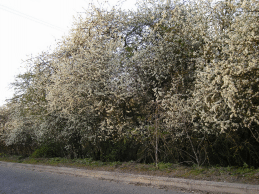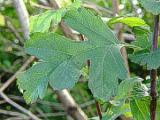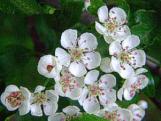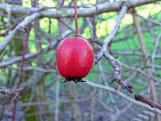Controverscial.Com
![]()
Welcome
![]()
|
Controverscial.Com
Welcome
|
|
|
Controverscial.Com
Welcome
|




The Hawthorn tree (Crataegus oxyacantha) is one of
the sacred trees of Wicca and Witchcraft, and is associated with “Beltane”
the “May Day” spring celebrations. Beltane
honours the Sun god Belenus whose festival originally commenced on the first day
the Hawthorn tree blossomed. It was
often referred to as the May tree because it traditionally flowered during the
month of May, and its blossoms used for Mayday decorations.
Today however due to seasonal fluctuations brought on through climate
change, it has been seen to flower as early as March and April, but Beltane is
still celebrated on the 1st of May.
In folklore the Hawthorn tree is known by many other names
such as: the May tree, Beltane
tree, Whitethorn, May blossom, Quick, Thorn, Haw, Halves, Hagthorn, Ladies’
Meat and the Bread and Cheese Tree. In
Ireland it is known as Sceach geal, in France L'épine noble and in Germany
Hagedorn. The German name of
Hagedorn means “Hedgethorn”, a name that comes from an early period when the
Germans divided their lands into plots by planting hedges of Hawthorn.
The word “haw” is also an old word for hedge.
Whitethorn comes from the whiteness of its bark and Quick from the speed
of it growth.
Worldwide there are over 1,000 species of the Hawthorn
tree, but native to Britain there are three main types: the English Hawthorn (C. oxyacanth), the Midland
Hawthorn (C. Laevigata) and the Common Hawthorn (C. monogyna).
The botanical name “Crataegus oxyacantha” is derived from the Greek
“kratos” meaning hardness (of the wood), “oxcus” (sharp) and
“akantha” (a thorn). The
Midland Hawthorn has several cultivated varieties that produces attractive
flowering clusters, some in pink and some in red, however this species and its
varieties are often susceptible to leaf spot, fire blight and fungi rust, which
causes early defoliation and decline.
The Hawthorn is a deciduous tree with dense leaves, thorny
branches and a short trunk. It
grows in all types of soil and can reach heights of up to 30 feet (9 meters).
It is also known for its longevity and can live to well over 400 years.
By late March into April the Hawthorns leaf-buds open and pale green
leaves appear on its branches. Interspersed
with the leaves are masses of tiny white flower buds, which when open from May
to June reveal flowers with five white petals surrounding stamens with bright
pink heads. Behind each flower is a
single seed-vessel that produces a separate fruit, these begin to appear in July
and ripen in October, by which time they resemble bright red miniature apples.
The English Hawthorn contains two to three seeds to each fruit, while the
Common Hawthorn contains a single seed. The
bark of a young tree is smooth and grey but as it grows and develops with age it
becomes gnarled and rutted with ridged fissures.
When cut back by coppicing the Hawthorn tree has the
ability to throw up new shoots from its base, which is why it has proved so
valuable as a hedge tree. Hedges of
Hawthorn provide dense cover and protection for many birds and small animals,
making ideal nesting places and shelter from predators. It also provides them with an abundance of food.
The flowers are important for many nectar-feeding insects of the
Lepidoptera species, such as butterflies and moths.
According to the RSPB (Royal Society for the Protection of Birds), the
Hawthorn provides food for over 150 species of insect, of which the sawfly,
shieldbug and cockchafer all live in the tree itself.
These as well as other carrion type insects fertilize the flowers, which
lends the tree a suggestion of decomposition in its perfume.



The wood of the Hawthorn is hard with a fine grain and lends itself to a beautiful polish, as such is used for making small luxury items such as walking sticks, handles for knives and daggers, and other fancy turned objects. The root-wood was used for making trinket boxes and combs for the ladies. The wood also makes excellent fuel and made the hottest wood-fire known, it was often considered more desirable than Oak for heating ovens. Charcoal made from its wood has been said to melt pig iron without the need for a blast furnace.
The Hawthorn is often used as a stock tree, not only for grafting varieties of its own species, but also for several other trees species that produce fruit, such as medlar and pear trees. Many other species of Hawthorns and their hybrids are used as ornamental or street trees. The tree can be grown from seeds or from cuttings, and grows rapidly for the first 15 years. Hedgerow trees are grown in seedbeds for the first 2 years and then transplanted into rows, they are normally ready to plant into hedges after 4 years. The laying of hedges to make them stock proof is an old country skill.
In Irish folklore the Hawthorn is sometimes referred to as
the fairy bush, due to the belief that fairy spirits inhabit the tree as
guardians, and since early times it has always been considered bad luck to cut
or damage the tree in fear of offending them.
However after due regard to the guardian spirit, the collecting of sprigs
and flowers from the tree particularly during the May Day celebrations was
allowed, and thereafter place in the home to banish evil influences.
In ancient Greece, crowns of Hawthorn blossoms were made
for wedding couples, and the wedding party all carried burning torches of
Hawthorn. The Roman goddess Cardea,
who presided over marriage and childbirth, was associated with the Hawthorn.
She was also known as the “White Goddess” and was the mistress of
Janus who guarded all doorways and portals, as such Cardea became known as the
“hinge of the door of the year”. Her primary symbol was a
Hawthorn branch and her festival was celebrated in May.
In iconography she is depicted carrying a bough of Hawthorn as a
protective emblem. This led to the practice of placing Hawthorn leaves in the
cradles of newborn children for protection.
The Hawthorn is often referred to in verse by the phase
“by Oak, Ash, and Thorn” (the “Thorn” referring to that of the Hawthorn
tree) and is used as a blessing during ritual, or to affirm a charge of power in
spell-craft. In folklore the Oak,
Ash, and Thorn was associated with portals leading into the realm of the
fairies, in which regard the Hawthorn with its connection to Cardea as the
“hinge on the door” became the guardian and protector of the entrances to
the Oak and Ash portals, and unless the Hawthorn allowed access to these
doorways, the fairy realm remained unseen.
As well as for hedges around his fields, the Hawthorn had
an additional benefit for the farmers of old, for cattle were known to thrive
within its protection. During birth
if a calf was premature, hanging its afterbirth on a Hawthorn tree was thought
to magically protect the calf and give it quick growth. The Hawthorn was also planted around Oak and Ash tree groves
in order to protect them from damage by storms or grazing cattle.
An early Christian legend about the Hawthorn begins with
the death of Christ and the myths
surrounding the Holy Grail. Christ’s
uncle was Joseph of Arimathea, who according to the Gospels of the New
Testament was a rich Jew and a member of the Sanhedrin, the ancient Jewish court
in Jerusalem. According to old Cornish legends he was also a tin merchant who traded with miners on
the west coast of Britain. On one
of his trading journeys he brought along his nephew, the boy Jesus and together
they made a pilgrimage to the Holy Isle of Avalon.
As the legend has
it, during the crucifixion Joseph collected
some of the blood of Jesus in a goblet
(one used during the Last Supper and known as the Holy Grail), and hid it
in a tomb. Years later Joseph returned to Avalon bringing the Holy Grail with him.
When he moored his boat on Wearyall Hill and stepped ashore, he planted
his staff in the ground where it took root and blossomed into a Hawthorn tree,
known today as the Glastonbury Thorn. This
was taken as a sign that Christianity would flourish in England and so Joseph
built the first Christian church in Britain at Glastonbury.
Somewhere nearby he also hid the Holy Grail, which has never been found
since.
In England heraldry the Hawthorn is the symbol of the House
of Tudor. This came about when on
the 22nd August 1485 at the Battle of Bosworth Field, Richard III
(the then King of England) was defeated and slain by Henry Tudor the Earl of
Richmond, during the battle the Royal Crown of England worn by Richard III got
lost or stolen. It was later found
hidden in a Hawthorn bush on the battlefield by Lord Stanley (Henry’s
stepfather), who symbolically placed it on Henry’s head.
Henry Tudor was crowned King on the 30th October 1485 and
became the first of the Tudor Kings dynasty of England who reigned through till
1603.
The Hawthorn has been used as a sedative, an anti-spasmodic
and a diuretic, and is a natural regulator of arterial blood pressure.
Known as “valerian of the heart”, the Hawthorn was most valued as a
heart stimulant, as such it was mainly used as a cardiac tonic for functional
heart troubles. As a useful
diuretic it was used in dropsy and in kidney troubles.
The flowers and berries are astringent and useful in decoctions to cure
sore throats. The leaves have been
used as an adulterant for tea, and an excellent liqueur brandy is made from its
berries.
Hawthorn berries also have a long history of use as a heart
tonic and have been used for centuries to aid circulation.
The Greeks used them primarily for heart disorders, while the Chinese
used them for both digestive and circulatory problems.
The toxicity count of Hawthorn berries is quite low and only becomes
evident in large doses, which makes it a relatively harmless heart tonic that
produces good results in many associated conditions.
The Hawthorn tree has long been associated fertility, and
still today in Mayday (Beltane) rituals, its blossoms are used to symbolise love
and the union of couples in marriage. Of
old young women would eagerly await the first blossoms to appear on the Hawthorn
tree, and when found after appropriate regard to the trees guardian spirit, a
sprig of the blossom would be taken and kept as a charm to encourage the
interest of a suitable husband.
Care should be taken to give due regard to the tree before removing any of
its branches. It is important not
to damage the tree in case the guardian spirit becomes angered.
Any Hawthorn tree standing alone should be avoided, and only parts from
trees forming hedges should be taken. The
Hawthorn tree is particularly sacred to the fairies,
and in Ireland and Britain is part of the
fairy-tree triad known as the: “Oak,
Ash and Thorn”, and where all three trees grow together it is said that one
may see the fairies.
Early on the dawn
of Mayday, men and women would bathe in the dew of the Hawthorn blossom
to increase health, luck
and beauty. Woman
who washed their faces in it would become beautiful, while men who washed their
hands in it would become skilled craftsmen.
Today in pagan Ireland, newly wed couple still adhere to the old
practice of dancing around a Hawthorn tree to bless and ensure a long and
fruitful marriage.
Off old,
the tree was regarded as a powerful symbol of protection, and was often
planted near a house to protect it against lightning and damage from storms.
In the past most Witch’s gardens contained at least one Hawthorn tree,
which as a guardian and protector of the entrances to the “Otherworld”,
protected the house against evil spirits. In
Ireland it is believed that food left over from the May Eve dinner should not be
thrown away or wasted, but left near the Hawthorn tree as an offering to the
spirits that inhabit the tree.
Also on May Eve it was an old custom to and make a wish by tie
ribbons or shreds of personal clothing onto a Hawthorn tree, especially where
they grew near wells. The strips of
cloth needed to be symbolically appropriate to the nature of the wish (i.e. blue
for health, pink or red for love, green or gold for prosperity).
These were said to be gifts for the fairies who dwelt in the tree, and if
pleased they would make your wish come true.
The Hawthorns wood is an ideal medium for making talismans
and wands, which can be used for protection, health and luck or used as a tool
in rituals to enhanced spiritual development and communication.
If you wish to cut a piece of live wood from a tree, be sure to do so
with due reverence and thanks to the tree’s guardian before hand.
As an alternative there are usually plenty of discarded branches to be
found particularly after heavy storms. To
make a talisman, strip off the bark while the branch is still green and before
it dries hard onto the wood, then store it outside until you are ready to work
on it, this will stop the wood from drying out too quickly.
Carving is more easily done on green wood than when it has dried out, for
the wood of the Hawthorn is especially hard. Wands can also be made in much the same way.
Another old custom was to make a Hawthorn globe or charm
ball from its twigs and foliage. Traditionally
this was made at first light on the old Celtic New Year’s Day (i.e. at
Samhain) and tied with a white ribbon. The old charm ball from the previous year was then burned on
a bonfire of straw, ash twigs and acorns. This
represented your old self with all the previous years troubles and sorrows being
consumed in the fire. Your new self
with all your hopes and aspirations can then be forged into the new globe and
hung in a safe place until the next New Year.
The Hawthorns deity associations are with: Blodeuwedd
(Welsh) a goddess of spring magickally created from flowers, Cardea (Roman) the
goddess who presides over marriage and childbirth, Flora (Roman) the goddess of
flowers, youth and spring, Hera (Greek) the goddess of women and marriage and
Hyman (Greek) a god of the marriage ceremony who carries the bridal torch made
from Hawthorn. Its gender type is
Masculine. Its planet ruler is
Mars. Its associated element is
Fire. It is used in association
with: Health Issues, Fertility,
Weddings, Protection, Death and Communication with the Spirit World.
Astrologically Hawthorn people (i.e. those who are born
during the month of May) are stubborn but loving people who tend to be very
beautiful in youth. They bring out
the worst in their friends but not in a bad way, more as a way of helping them
to root out bad habits and attitudes. They
are supportive and protective of all they consider to be family.
They can be tough to work with and have a single-minded attitude.
They do not joke around but attend only to the business at hand, which
makes them very shrewd business people. They
are very dependable and stable, and won’t go back on their words.
![]()
Cunningham's Encyclopedia Of Magical Herbs - By Scott Cunningham.
Encyclopedia of Wicca & Witchcraft - By Raven Grimassi.
The Encyclopedia of Witches & Witchcraft - By Rosemary Ellen Guiley.
Tree Wisdom (The difinitive guidebook to the myth, folklore and healing power of Trees) - By Jacqueline Memory Paterson.
AA Book of Britain's Countryside.
The Penguin Hutchinson Reference Library (CD cassette).
Microsoft Encarta Encyclopedia (CD cassette).
Plus many websites to numerous to mention.
This article is now showing with my permission at:
http://groups.msn.com/SpringofNiksa
![]()
![]()

Let there be peace in the world - Where have all the flowers gone?
My Personal Page / My Place in England, UK / My Family Tree (Ancestry)
Wicca/Witchcraft / What is Wicca / What is Magick
Traditional Writings:
Wiccan Rede / Charge of the Goddess / Charge of the God / The Three-Fold Law (includes The Law of Power and The Four Powers of the Magus) / The Witches Chant / The Witches Creed / Descent of the Goddess / Drawing Down the Moon / The Great Rite Invocation / Invocation of the Horned God / The 13 Principles of Wiccan Belief / The Witches Rede of Chivalry / A Pledge to Pagan Spirituality
Correspondence Tables:
Incense / Candles / Colours / Magickal Days / Stones and Gems / Elements and Elementals
Traditions Part 1 - Alexandrian Wicca / Aquarian Tabernacle Church (ATC) / Ár Ndraíocht Féin (ADF) / Blue Star Wicca / British Traditional (Druidic Witchcraft) / Celtic Wicca / Ceremonial Magic / Chaos Magic / Church and School of Wicca / Circle Sanctuary / Covenant of the Goddess (COG) / Covenant of Unitarian Universalist Pagans (CUUPS) / Cyber Wicca / Dianic Wicca / Eclectic Wicca / Feri Wicca /
Traditions Part 2 - Gardnerian Wicca / Georgian Tradition / Henge of Keltria / Hereditary Witchcraft / Hermetic Order of the Golden Dawn (H.O.G.D.) / Kitchen Witch (Hedge Witch) / Minoan Brotherhood and Minoan Sisterhood Tradition / Nordic Paganism / Pagan Federation / Pectic-Wita / Seax-Wica / Shamanism / Solitary / Strega / Sylvan Tradition / Vodoun or Voodoo / Witches League of Public Awareness (WLPA) /
Gods and Goddesses (Greek
Mythology) / Esbats &
Full Moons / Links
to Personal Friends & Resources / Wicca/Witchcraft
Resources / What's a spell? /
Circle Casting and
Sacred Space / Pentagram
- Pentacle / Marks
of a Witch / The Witches
Power / The Witches Hat
/ An
esoteric guide to visiting London / Satanism
/ Pow-wow
/ The
Unitarian Universalist Association / Numerology: Part 1
/ Part 2 / Part
3 / A
history of the Malleus Maleficarum: includes: Pope
Innocent VIII /
The
papal Bull /
The
Malleus Maleficarum /
An extract from the Malleus Maleficarum
/ The letter of approbation
/ Johann
Nider’s Formicarius /
Jacob
Sprenger /
Heinrich Kramer /
Stefano Infessura
/ Montague Summers /
The Waldenses
/ The Albigenses
/
The Hussites / The
Sun Dance
/ Shielding (Occult
and Psychic Protection) /
Sabbats in History and Mythology / Samhain (October 31st) / Yule (December 21st) / Imbolc (February 2nd) / Ostara (March 21st) / Beltane (April 30th) / Litha (June 21st) / Lughnasadh (August 1st) / Mabon (September 21st)
Rituals contributed by Crone: Samhain / Yule / Imbolc / Ostara / Beltane / Litha / Lammas / Mabon
Tools of a Witch / The Besom (Broom) / Poppets and Dolls / Pendulums / Cauldron Magick / Mirror Gazing
Animals in Witchcraft (The Witches Familiar) / Antelope / Bats / Crow / Fox / Frog and Toads / Goat / Honeybee / Kangaroo / Lion / Owl / Phoenix / Rabbits and Hares / Raven / Robin Redbreast / Sheep / Spider / Squirrel / Swans / Wild Boar / Wolf / Serpent / Pig / Stag / Horse / Mouse / Cat
In Worship of Trees - Myths, Lore and the Celtic Tree Calendar. For descriptions and correspondences of the thirteen sacred trees of Wicca/Witchcraft see the following: Birch / Rowan / Ash / Alder / Willow / Hawthorn / Oak / Holly / Hazel / Vine / Ivy / Reed / Elder. Also see: The Willow Tree (Folk Music)
Mystical Sacred Sites - Stonehenge / Glastonbury Tor / Malta - The Hypogeum of Hal Saflieni / Avebury / Cerne Abbas - The Chalk Giant / Ireland - Newgrange /
Rocks and Stones:
Stones - History, Myths and Lore
Articles contributed by Patricia Jean Martin: / Apophyllite / Amber / Amethyst / Aquamarine / Aragonite / Aventurine / Black Tourmaline / Bloodstone / Calcite / Carnelian / Celestite / Citrine / Chrysanthemum Stone / Diamond / Emerald / Fluorite / Garnet / Hematite / Herkimer Diamond / Labradorite / Lapis Lazuli / Malachite / Moonstone / Obsidian / Opal / Pyrite / Quartz (Rock Crystal) / Rose Quartz / Ruby / Selenite / Seraphinite / Silver and Gold / Smoky Quartz / Sodalite / Sunstone / Thunderegg / Tree Agate / Zebra Marble
Wisdom:
Knowledge vs Wisdom by Ardriana Cahill / I Talk to the Trees / Awakening / The Witch in You / A Tale of the Woods
Articles and Stories about Witchcraft:
Murder by Witchcraft / The Fairy Witch of Clonmel / A Battleship, U-boat, and a Witch / The Troll-Tear (A story for Children) / Goody Hawkins - The Wise Goodwife / The Story of Jack-O-Lantern / The Murder of the Hammersmith Ghost / Josephine Gray (The Infamous Black Widow) / The Two Brothers - Light and Dark
Old Masters of Academia:
Pliny the Elder / Hesiod / Pythagoras
Abramelin the Mage / Agrippa / Aidan A. Kelly / Albertus Magnus “Albert the Great” / Aleister Crowley “The Great Beast” / Alex Sanders "the King of the Witches” / Alison Harlow / Amber K / Anna Franklin / Anodea Judith / Anton Szandor LaVey / Arnold Crowther / Arthur Edward Waite / Austin Osman Spare / Biddy Early / Bridget Cleary / Carl Llewellyn Weschcke / Cecil Hugh Williamson / Charles Godfrey Leland / Charles Walton / Christina Oakley Harrington / Damh the Bard (Dave Smith) / Dion Fortune / Dolores Aschroft-Nowicki / Dorothy Morrison / Doreen Valiente / Edward Fitch / Eleanor Ray Bone “Matriarch of British Witchcraft” / Dr. John Dee and Edward Kelly / Dr. Leo Louis Martello / Eliphas Levi / Ernest Thompson Seton / Ernest Westlake and the Order of Woodcraft Chivalry / Fiona Horne / Friedrich von Spee / Francis Barrett / Gerald B. Gardner / Gavin and Yvonne Frost and the School and Church of Wicca / Gwydion Pendderwen / Hans Holzer / Helen Duncan / Herman Slater "Horrible Herman" / Israel Regardie / James "Cunning" Murrell / Janet Farrar & Gavin Bone / Jessie Wicker Bell “Lady Sheba” / John Belham-Payne / John George Hohman / John Gerard / John Gordon Hargrave (the White Fox) / John Michael Greer / John Score / Johannes Junius the Burgomaster of Bamberg / Joseph John Campbell / Karl von Eckartshausen / Laurie Cabot "the Official Witch of Salem" / Lewis Spence / Margaret Alice Murray / Margot Adler / Marie Laveau the " Voodoo Queen of New Orleans" / Marion Weinstein / Matthew Hopkins “The Witch-Finder General” / Max Ehrmann and the Desiderata / Monique Wilson the “Queen of the Witches” / Montague Summers / Nicholas Culpeper / Nicholas Remy / M. R. Sellers / Mrs. Grieve "A Modern Herbal" / Oberon and Morning Glory Zell-Ravenheart / Old Dorothy Clutterbuck / Old George Pickingill / Paddy Slade / Pamela Colman-Smith / Paracelsus / Patricia Crowther / Patricia Monaghan / Patricia “Trish” Telesco / Philip Emmons Isaac Bonewits / Philip Heselton / Raymond Buckland / Reginald Scot / Robert Cochrane / Robert ‘von Ranke’ Graves and "The White Goddess" /
Rudolf Steiner / Rosaleen Norton “The Witch of Kings Cross” / Ross Nichols and The Order of Bards, Ovates & Druids / Sabrina - The Ink Witch / Scott Cunningham / Selena Fox / Silver Ravenwolf / Sir Francis Dashwood / Sir James George Frazer / S.L. MacGregor Mathers and the “Hermetic Order of the Golden Dawn” / Starhawk / Stewart Farrar / Sybil Leek / Ted Andrews / The Mather Family - includes: Richard Mather, Increase Mather, Cotton Mather / Thomas Ady / Vera Chapman / Victor Henry Anderson / Vivianne Crowley / Walter Brown Gibson / William Butler Yeats / Zsuzsanna Budapest
Many of the above biographies are brief and far from complete. If you know about any of these individuals and can help with aditional information, please cantact me privately at my email address below. Many thanks for reading :-)
While I have taken due care and dilligence to credit all sources where possible, this website may contain copyrighted material which has not been specifically authorized by the copyright owner. My use of making such material available here is done so in my efforts to advance our understanding of religious discrimination, the environmental and social justice issues etc. If you wish to use copyrighted material from this wedsite for purposes of your own then you must obtain permission from the relevant copyright owner yourself.
![]()
My online email discussion group:
http://groups.yahoo.com/group/Email_Witches

Help send a message of peace around the world! The Dove of Peace flies from site to site, through as many countries as possible. It does not belong to ANY belief system. Please help make a line around the globe by taking it with you to your site, by giving it to someone for their site, by passing it on to another continent or to the conflict areas of the world. May trouble and strife be vanquished in it's path.

mailto:George@controverscial.com
![]()
|
|